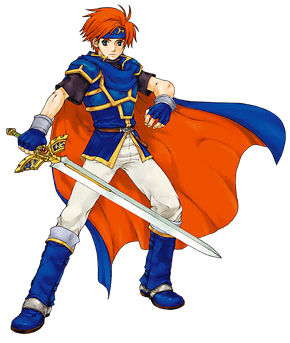
Roy is a fictional character from Nintendo's Fire Emblem video game series who, alongside Marth, first appeared in the 2001 crossover fighting game Super Smash Bros. Melee as a representative character from the Fire Emblem series. He is the lead character of Fire Emblem: The Binding Blade; within the story, he is the son of Eliwood and heir presumptive of Pherae, who eventually becomes a major military leader. The inclusion of Roy and Marth in Melee is cited as one of the reasons Nintendo started localizing the series for international distribution. Roy continues to make recurring appearances in subsequent Fire Emblem media, such as a manga series and spinoff video games.
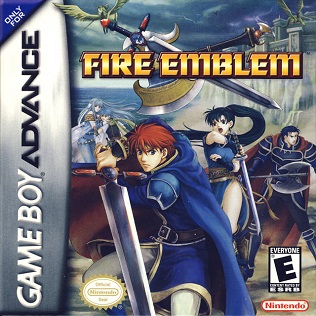
Fire Emblem: The Blazing Blade, also known simply as Fire Emblem, is a tactical role-playing game developed by Intelligent Systems and published by Nintendo for the Game Boy Advance handheld video game console. It is the seventh installment in the Fire Emblem series, the second to be released for the platform after Fire Emblem: The Binding Blade, and the first to be localized for international audiences. It was released in Japan and North America in 2003, and in Europe and Australia in 2004.
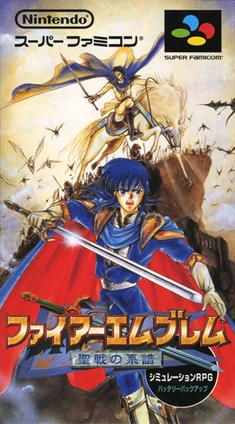
Fire Emblem: Genealogy of the Holy War is a tactical role-playing game developed by Intelligent Systems and published by Nintendo for the Super Famicom home video game console in 1996. It is the fourth installment of the Fire Emblem series, and the second to be developed for the platform. Genealogy of the Holy War takes place on the continent of Jugdral, split between eight countries founded by the Twelve Crusaders, an ancient group of soldiers who ended the rule of the ancient dragon Loptous with divine aid. In the present, a cult working to revive Loptous stirs up war among the countries. The story is told over two generations—the first generation follows the Grannvalian prince Sigurd, while the second follows his son Seliph as he works to defeat the cult and avenge his father. Gameplay follows the traditional Fire Emblem system of tactical battles taking place on grid-based maps, while adding the Weapon Triangle and Support systems, which directly impacted both gameplay and story.

Fire Emblem Gaiden is a tactical role-playing game developed by Intelligent Systems and published by Nintendo for the Famicom. Released in March 1992, it is the second installment in the Fire Emblem series and the last to be developed for the Famicom. It builds upon the basic turn-based strategy gameplay of the previous title, while including new elements such as a navigable overworld. Set in the same world as its predecessor, Fire Emblem: Shadow Dragon and the Blade of Light, Gaiden follows the battles of two opposing armies on the continent of Valentia, which is torn apart by political strife involving the princess Celica and her childhood friend Alm.

Fire Emblem: The Sacred Stones is a tactical role-playing game developed by Intelligent Systems, and published by Nintendo for the Game Boy Advance handheld video game console in 2004 for Japan and 2005 in the West. It is the eighth entry in the Fire Emblem series, the second to be released outside Japan, and the third and final title to be developed for the Game Boy Advance after The Binding Blade and its prequel Fire Emblem.

Fire Emblem: Shadow Dragon and the Blade of Light is a tactical role-playing video game developed by Nintendo and Intelligent Systems and published by Nintendo for the Famicom. It is the first installment in the Fire Emblem series and was originally released in Japan in 1990. Set on the fictional continent of Archanea, the story follows the tale of Marth, prince of the kingdom of Altea, who is sent on a quest to reclaim his throne after being forced into exile by the evil sorcerer Gharnef and his dark master Medeus, the titular Shadow Dragon. Forming new alliances with neighboring kingdoms, Marth must gather a new army to help him retrieve the sacred sword Falchion and the Fire Emblem shield in order to defeat Gharnef and Medeus and save his kingdom. The gameplay revolves around turn-based battles on grid-based maps, with defeated units being subject to permanent death.

Ike is a character from the Fire Emblem series of video games. He is the central protagonist and Lord-class character of the ninth game in the series, Fire Emblem: Path of Radiance, and one of the central characters in Fire Emblem: Radiant Dawn. Ike is one of the most popular characters in the Fire Emblem series, and has appeared in other media, most notably the Super Smash Bros. fighting game series.

Fire Emblem: Path of Radiance is a 2005 tactical role-playing video game developed by Intelligent Systems and Nintendo SPD, and published by Nintendo for the GameCube. It is the ninth main installment in the Fire Emblem series, and the third to be released in the west. As with previous installments, gameplay revolves around positioning characters on a battlefield to defeat an opposing force. If characters are defeated in battle, they are removed from the rest of the game.

Fire Emblem: Thracia 776 is a tactical role-playing game developed by Intelligent Systems and published by Nintendo for the Super Famicom; it was originally released through the Nintendo Power flash cartridge in 1999, then on a ROM cartridge the following year. It is the fifth installment in the Fire Emblem series, the third and last title to be developed for the Super Famicom, and the last home console Fire Emblem until the release of Fire Emblem: Path of Radiance in 2005.

Fire Emblem: The Binding Blade is a tactical role-playing game developed by Intelligent Systems and published by Nintendo for the Game Boy Advance (GBA) handheld video game console. It is the sixth entry in the Fire Emblem series, the first title produced for the system, and the first title to appear on a handheld console. It was released in Japan in March 2002.
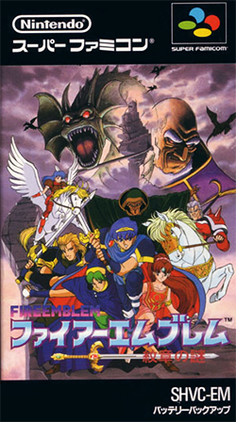
Fire Emblem: Mystery of the Emblem, known in Japan as Fire Emblem: Monshō no Nazo, is a tactical role-playing video game developed by Intelligent Systems, and published by Nintendo for the Super Famicom home video game console in 1994. It is the third installment of the Fire Emblem series, and the first to be developed for the Super Famicom. The story is divided into two parts: the first part is a retelling of Fire Emblem: Shadow Dragon and the Blade of Light, while the second is an original story acting as a sequel to the first game. After defeating the sorcerer Gharnef and the Dark Dragon Medeus, peace is restored to Archanea and Marth restores his kingdom. His ally Hardin ascends to the throne of Archanea, but begins hostile military expansion across the continent, forcing Marth to confront his old friend and the force driving him. Gameplay follows the traditional Fire Emblem system of tactical battles taking place on grid-based maps.

Fire Emblem: Shadow Dragon is a tactical role-playing video game developed by Intelligent Systems and published by Nintendo for the Nintendo DS. It is the eleventh installment in the Fire Emblem series and a remake of the Famicom title Fire Emblem: Shadow Dragon and the Blade of Light, the first entry in the series. It released in 2008 in Japan and Europe, and 2009 in North America and Australia.

Fire Emblem Awakening is a 2012 tactical role-playing game developed by Intelligent Systems and published by Nintendo for the Nintendo 3DS. It is an installment of the Fire Emblem series, and the first to be developed for the Nintendo 3DS. The gameplay, like previous Fire Emblem games, focuses on the tactical movement of characters across a grid-based battlefield and fighting enemy units. Other features include the ability to build and foster relationships between characters to improve their abilities and multiple camera perspectives in battle.

Fire Emblem Fates is a tactical role-playing video game for the Nintendo 3DS handheld video game console, developed by Intelligent Systems and Nintendo SPD and published by Nintendo. It was released in June 2015 in Japan, then released internationally in 2016. It is the fourteenth installment in the Fire Emblem series and the second to be developed for Nintendo 3DS after Fire Emblem Awakening. Unlike previous titles, Fates was released in three versions, each following a different storyline centered on the same characters: Birthright and Conquest as physical releases, and Revelation as downloadable content.

Fire Emblem: New Mystery of the Emblem is a tactical role-playing game developed by Intelligent Systems and published by Nintendo for the Nintendo DS handheld video game console in July 2010. It is the twelfth entry in the Fire Emblem series, and a remake of the Super Famicom title Fire Emblem: Mystery of the Emblem. The story is based on the original content from Mystery of the Emblem, while including a customizable Avatar as the main character alongside Marth, the protagonist of Shadow Dragon and the Blade of Light. New Mystery of the Emblem also adapts the story content from the Satellaview title BS Fire Emblem into four additional story episodes dubbed the "New Archanea Chronicles".

Fire Emblem Warriors is a hack and slash action role-playing game developed by Omega Force and Team Ninja, and published by Koei Tecmo in Japan and Nintendo internationally for the Nintendo Switch and New Nintendo 3DS. The game was released in Japan in September 2017, and worldwide the following month. The game is a collaboration between Koei Tecmo's Dynasty Warriors franchise and Nintendo and Intelligent Systems's Fire Emblem series.
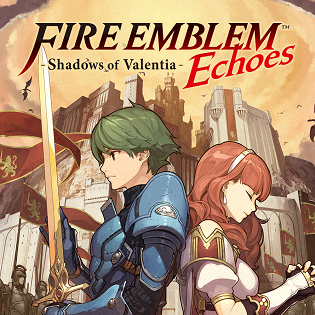
Fire Emblem Echoes: Shadows of Valentia is a tactical role-playing video game developed by Intelligent Systems and published by Nintendo for the Nintendo 3DS in 2017. It is the fifteenth installment in the Fire Emblem series and a remake of the 1992 Famicom game Fire Emblem Gaiden, the second entry in the series. It follows dual protagonists Alm and Celica as they aim to bring an end to the war through opposite methods, with Alm fighting to resolve the war through battle, while Celica attempts to find a peaceful end through guidance from the Goddess Mila. Fire Emblem Echoes carries over the core gameplay mechanics of the Fire Emblem series while incorporating mechanics from Gaiden like dungeon crawling.

Fire Emblem: Three Houses is a tactical role-playing video game developed by Intelligent Systems and Koei Tecmo's Kou Shibusawa and published by Nintendo for the Nintendo Switch. It was released worldwide on July 26, 2019. It is the sixteenth entry in the Fire Emblem series and the first one for home consoles since Fire Emblem: Radiant Dawn, originally released in 2007.
Fire Emblem Fates is a tactical role-playing video game for the Nintendo 3DS, developed by Intelligent Systems and Nintendo SPD and published by Nintendo. It was released in June 2015 in Japan and internationally in 2016, and was the second installment in the series to be developed for the 3DS after Fire Emblem Awakening. Unlike previous titles, Fates was released in three versions, each following a different storyline centered on the same characters: Birthright and Conquest as physical releases, and Revelation as downloadable content.
















